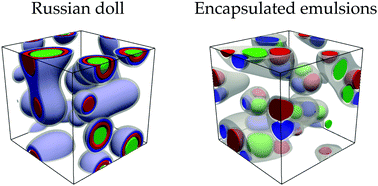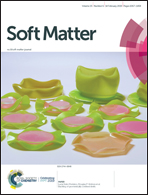Phase behavior and morphology of multicomponent liquid mixtures†
Abstract
Multicomponent systems are ubiquitous in nature and industry. While the physics of few-component liquid mixtures (i.e., binary and ternary ones) is well-understood and routinely taught in undergraduate courses, the thermodynamic and kinetic properties of N-component mixtures with N > 3 have remained relatively unexplored. An example of such a mixture is provided by the intracellular fluid, in which protein-rich droplets phase separate into distinct membraneless organelles. In this work, we investigate equilibrium phase behavior and morphology of N-component liquid mixtures within the Flory–Huggins theory of regular solutions. In order to determine the number of coexisting phases and their compositions, we developed a new algorithm for constructing complete phase diagrams, based on numerical convexification of the discretized free energy landscape. Together with a Cahn–Hilliard approach for kinetics, we employ this method to study mixtures with N = 4 and 5 components. We report on both the coarsening behavior of such systems, as well as the resulting morphologies in three spatial dimensions. We discuss how the number of coexisting phases and their compositions can be extracted with Principal Component Analysis (PCA) and K-means clustering algorithms. Finally, we discuss how one can reverse engineer the interaction parameters and volume fractions of components in order to achieve a range of desired packing structures, such as nested “Russian dolls” and encapsulated Janus droplets.

- This article is part of the themed collection: Soft Matter Emerging Investigators


 Please wait while we load your content...
Please wait while we load your content...